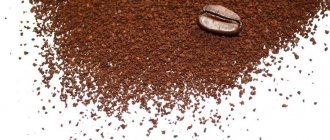- Reports and messages
- Plants
- Coffee
Coffee is the favorite drink of most adults.
When and where did he first appear? Ethiopia can safely be called the birthplace of coffee. Already in 900 AD. the inhabitants of this country discovered the wonderful properties of the plant. Gradually, coffee spread to other countries where the climate turned out to be favorable for its cultivation. Currently, the main coffee producers are Brazil, Vietnam, Colombia, Ethiopia, Cuba, India and many other countries. Coffee beans grow on coffee trees. The main varieties of coffee are Arabica and Robusta. Coffee beans are formed inside the berries that appear on the tree. When they ripen, they turn red.
Arabica beans are harvested in several stages because the berries ripen unevenly. With Robusta, everything is much simpler: the grains can hang on the tree and dry, since they do not fall to the ground. Drinks made from Arabica are more aromatic. Robusta, in turn, contains more caffeine. Both varieties complement each other perfectly.
From one tree you can collect up to 3 kg of berries. This amount yields 400 g of roasted coffee beans. Manual berry picking is preferred because the quality of the grains is much higher than with automated harvesting.
Stages of processing coffee beans: roasting, grinding and possible processing into artificial coffee.
When roasted, the beans change color from green to brown. There are four degrees of roasting. Espresso is made from the darkest roasted beans.
Ground coffee loses some of its taste and aroma, so it is worth grinding the beans immediately before preparing the drink.
Instant coffee is easy to prepare, but it loses its natural taste. Most often, coffee is prepared in a coffee maker, Turk or French press.
Coffee, like any other product, can bring both benefits and harm to the body. With moderate consumption of the drink, the human body is not in danger. Coffee helps you cheer up and has a positive effect on the brain, muscles and internal organs.
Goats helped us learn about coffee
Interesting facts and legends about coffee, of which there are many, indicate that this drink is very loved and consumed for a long time. It first became known in Ethiopia. The shepherd Koldi saw that the goats were eating berries, after which they became active and did not sleep even at night.
When he tried them himself, he noted that he became more alert. He shared his observation with others, and people began to eat these berries. And only after some time they began to prepare a drink from the grains. Such stories about coffee are distinguished by their originality.
Where was coffee born as a drink?
In short, the history of coffee begins in the distant 10th century in hot Ethiopia. According to one legend, the idea of using the fruits and leaves of the coffee tree came to an ordinary shepherd, who noticed how the goats he was herding were frolicking after eating leaves and berries from a small tree in the mountains.
It was in the vicinity of a settlement called Kaffa. Soon its residents began actively preparing the drink, first from the leaves of the coffee tree, and then from fresh fruits. But the monks of the surrounding monasteries began to dry the berries and make coffee from it, and through trial and error they received the first recipe for making an invigorating drink. It was prepared not only from grains, but also from dried husks. It was the invigorating properties that prompted the monks to experiment and look for better ways to use coffee. This is a brief history of the emergence of a new product, which stretched for almost 2 centuries.
The first coffee plantations appeared in Yemen and brought prosperity to the country for several centuries to come.
Only by the 12th century did coffee culture take shape more clearly. A drink made from leaves and grains began to be prepared throughout the African continent, and it began to conquer the entire East.
Soon, coffee trees began to be grown on plantations in order to obtain greater yields and profits. This idea first occurred to one of the rulers of Yemen. For almost 200 years, this country was the main supplier of grain to the entire East, from where the expensive product began to conquer Europe.
At the beginning of the 15th century, coffee beans began to be roasted over an open fire for the first time. This merit belongs to the Turks, and they called the drink made from roasted grains Kahwa, and only after another 2 centuries it acquired its current name - coffee.
How did an unusual invigorating product penetrate into Europe? This happened only at the beginning of the 17th century. The origin of coffee and its properties were greatly exaggerated, but the taste was liked by many monarchs who gave the go-ahead to the common people to drink this drink. The triumphal march of coffee around the world begins in Italy, or more precisely, Venice, where a doctor accompanying the Venetian embassy brought several beans from Egypt. It was there that the guests were offered a hot black drink, which everyone really liked. Trade routes were quickly established between Venice and the countries of the East that grew coffee trees.
Prospero Alpini - the doctor who first described coffee as a medicinal drink and brought it to Italy
It was in Venice that the first coffee shops appeared, which became centers of social life. The first coffee to arrive in Europe was African Mocha, which gave a rich chocolate aroma and a pleasant taste. Despite the fact that Ethiopia is considered the country of origin of coffee, Yemen and Egypt began supplying the product to the world market. One of the first coffee houses, which still exists today under the name Florian, appeared in Piazza San Marco in 1720.
From Italy, grains in bags came to England, then to Holland, Austria, France, Germany and Russia. It is believed that the drink became widespread with the light hand of Peter I, but the first coffee shops were opened here after 1740. Today Russia is considered one of the most coffee-drinking countries in the world. By the way, the appearance of coffee was preceded by black tea, which was positioned as a dried invigorating herb.
Where do coffee beans come from?
The berries grow on trees that can reach a height of 9 meters. Trees react negatively to temperature changes. Therefore, they grow in warm climates with stable weather conditions. However, most often they are made lower to make it convenient to pick the fruits.
Large white fragrant flowers appear on the tree first, which then ripen into red berries, although these may vary slightly in color depending on the type of tree. There is grain inside. It is then processed, ground into powder and a flavored drink is prepared.
Effect on the nervous system
The main biological component of coffee, due to which the addiction to this drink arises, is caffeine. It has been proven that caffeine is a stimulant that acts through parts of the brain on the central nervous system and circulatory systems. Taking it causes a feeling of vivacity, a surge of strength, and also relieves headaches. Since caffeine stimulates the activity of the central nervous system, this means that coffee improves brain function, increases overall performance and endurance. This is why “coffee break” is so recommended for people working in offices, especially taking into account the fact that this category of citizens most often suffers from neuroses.
However, the effect of caffeine on each person is individual and depends on the type of nervous system. Depending on how intensively caffeine is broken down by the body, the effect of caffeine on it is determined; some people experience a state of excitement, while others may experience drowsiness and lethargy. The ability to break down caffeine is inherent in the body at the genetic level and therefore it is almost impossible to determine the optimal dose of caffeine for the body, and very often it is exceeded several times. And even a small and not very long-term excess of the individual dose leads to depletion of nerve cells and disruption of the normal functioning of the body. Subsequently, people who exceed their dose for many years may experience behavioral deviations, neuroses, depression, irritability, increased anxiety, lethargy and other signs of nervous disorders, to which regular increased consumption can predispose and be one of the reasons for their occurrence. caffeine
Where is it produced?
There are many types of coffee trees, but most people prefer Arabica, as this type has a slightly bitter taste and a pleasant aroma. Plantations growing these fruits are located in Central and South America, Africa and Asia. The country of coffee is Brazil. It is the largest supplier of this invigorating drink. Colombia supplies 15% of the total. Moreover, Arabica beans from this country are especially valued, as they have high quality and original taste. In general, it should be noted that coffee ranks second after oil in global trade turnover. The use of this drink is widespread on all continents, so it is always in high demand. Which country consumes the most coffee? It is believed that Finland.
Effects on the digestive system
Coffee is harmful to the digestive system, as a rule, due to the fact that many people drink it incorrectly. Coffee contains tannins that can dry out the stomach lining, so it is not recommended to drink coffee on an empty stomach. The most harmful to the stomach is instant coffee, which is the most common among consumers. As a result, there are unpleasant consequences, heartburn, gastritis, which may well predispose to the appearance of gastric ulcers. It is better to drink coffee after meals, preferably even some time after the main meal. Coffee is contraindicated during exacerbation of chronic gastritis and ulcers.
In addition, caffeine increases the contraction of the intestinal walls. Therefore, frequent consumption of coffee can lead to indigestion and impaired absorption of nutrients. At the same time, this property of coffee - a mild laxative effect - can be useful.
At the same time, moderate coffee consumption can protect alcohol lovers from liver cirrhosis. As the British newspaper The Times notes, Norwegian scientists have concluded that three cups of coffee a day can neutralize the negative effects of alcohol on the human body.
Data
Interesting facts about coffee have appeared over the years, so now there are a great many of them known. Let's take a look at some:
- This drink is the most popular in the world.
- In Japan, a holiday appeared in his honor. Coffee Day is celebrated on October 1st. Japan ranks third in terms of consumption of this drink.
- There is a Musanga animal that eats only coffee beans, and its excrement is then used to make a drink. By the way, it is the most expensive in the world.
- The lethal dose is 100 cups per day. If you drink such an amount, a person’s heart will not stand it.
- Coffee, if you do not add sugar, cream and milk, is an absolutely calorie-free drink.
- When this drink appeared in Russia, people did not immediately recognize it. Therefore, supporters of Peter I began to invent stories about him so that he would become popular.
- A cup of coffee won't hurt anyone. It is believed that it is safe to drink no more than 500-600 ml per day, that is, approximately 3-4 cups of 150 ml.
- Drinking the drink helps prevent Parkinson's disease, dementia, and coffee, being a strong antioxidant, prevents the formation of cancer cells.
- Coffee is used in cosmetology. In some countries they take baths with it to make the skin elastic. There are also many recipes for scrubs and masks based on ground grains.
- This drink inhibits the development of gallstone disease.
- It can also cause heartburn. The reason for this is the acid contained in it.
Report No. 2
Coffee is one of the indispensable and most popular drinks in modern society, which is considered the most aromatic in the world. Origin.
Initially, as legends say, coffee originated more than 1,500 thousand years ago in the 3rd century AD in Ethiopia. It is in this state that coffee still grows like a wild plant. However, it was brought into the public domain from Yemen, where it was supplied as contraband by the Arabs, from whom specific documented information was later discovered in the 10th century.
In the 17th century, there was a great demand for coffee, which is why many Europeans began to look for tropical places suitable for growing these plants. The Dutch were the first. They were able to steal some grains from the Arabs, after which they planted them in Amsterdam. A few years later, thanks to this, the famous biologist Carl Leaneus created an entire plantation that he called: “Arabica Coffee.”
And although its history is so rich, coffee began to be studied in depth relatively recently: about a couple of decades ago.
Growing.
Coffee beans are very finicky when cultivated, especially the above-mentioned Arabica variety, therefore when growing, the first thing to take into account is the temperature, which should not exceed 20-25°C and becomes below 8°C.
Soil is also an important component. Most people use loose soil with an average moisture and nutrient content.
Varieties.
The coffee tree belongs to the Madder family, which includes 60-80 varieties; only 3 are cultivated in all 80 countries: Arabica, Robusta and Liberica. There are several types of coffee on the market:
- Grain
- Ground
- Soluble
- A recently introduced milicano that combines the properties of the previous two.
Numerous drinks made from these grains are common in industry, in addition to the main one:
- Espresso
- Cappuccino
- Glasse
- Latte
- Mocha
- Mocaccino
- Americano
- Ristretto
- Romano
- Turkish coffee, which is regular strong brewed black coffee.
Effect on the human body.
Coffee has both negative and positive effects on the human body. In first place is caffeine, which dilates blood vessels, accelerating blood circulation, which is why people subsequently feel alert. However, in recent years it has been discovered that it also lowers the concentration of proteins in the brain, which helps relieve dementia. When drinking a drink, a person feels euphoria - joy, but if you drink too much, its advantages will turn into disadvantages, therefore the recommended amount is 3-4 cups per day.
Interesting Facts.
Many people who believe in paranormal events claim that the number 8, denoting infinity, is closely associated with coffee, which is why new legends are born that it is marked by higher powers.
5th grade
Some more facts about this wonderful drink
- Instant coffee, which is now available and distributed throughout the world, was invented by George Washington back in 1910.
- In ancient times, the drink was believed to have medicinal properties. Interesting facts about coffee are known. For example, the fact that it was used as medicine to prevent diseases of the stomach and intestines, to calm the nervous system.
- There was a period when the drink was prohibited, for example, by priests. They believed that people were becoming dependent on this drink, so they were categorically against its use.
- Caffeine is on the list of prohibited substances contained in the body of athletes. Therefore, if it is detected, the competitor will not undergo doping control.
- Modern doctors deny that coffee increases blood pressure. Although this is precisely the opinion that doctors held for a long time and forbade hypertensive patients from drinking this drink.
- Since coffee has a diuretic effect, it therefore prevents fluid retention in the body. Excessive consumption can lead to dehydration.
- In one of the small towns in England, coffee is used as fuel. A power plant was built there, which requires coffee grounds to operate.
- Alcohol is prohibited for Muslims, so they replace it with coffee.
- Excessive consumption of the drink interferes with the absorption of calcium, and can also lead to insomnia and irritability.
- In Arab countries, making coffee is a man's responsibility. If he does not do this, it may lead to divorce.
- Famous people who were coffee drinkers include the great composer Beethoven and the philosopher Voltaire.
- The thicket has been used for fortune telling since ancient times and to this day.
- Drinking an invigorating drink daily helps improve memory.
- Coffee can be used for household purposes. It is suitable for cleaning pots and washing dishes. You can also renew leather clothes and make them shine by wiping them with a swab dipped in strong coffee.
Effects on the cardiovascular system
It has been proven that coffee increases cardiac activity, stimulates the vasomotor center, and increases the pulse rate. It can also cause an increase in blood pressure in people who rarely drink coffee, although only briefly and insignificantly. Thus, the harm of coffee is visible for people with arterial hypertension, coronary heart disease and other diseases of the cardiovascular system, as well as for those who are predisposed to these diseases. By the way, people who drink more than 6 cups of coffee a day also run the risk of developing heart problems. For people not predisposed to heart disease, coffee cannot cause much harm. In addition, in the case of low blood pressure, many people successfully improve their well-being with a cup of coffee.
An interesting fact is that the harm of coffee to the cardiovascular system depends on the method of preparing coffee. Coffee prepared by brewing is in this sense much more harmful than drink from coffee makers.
How was the drink distributed in Russia?
Coffee appeared in Russia thanks to Peter I. It was he who once tried this drink abroad and decided to bring it with him. The ruler liked its taste and aroma so much that he began to gather nobles and treat them to coffee.
Then public coffee shops appeared. All other residents of the country could try the drink there. Now coffee has not lost its popularity. Thanks to its availability, everyone can afford to consume it daily.
Abstract: Coffee and coffee drinks
Coffee
Natural coffee is obtained from the seeds of the coffee tree, which grows in all tropical countries. The coffee tree does not grow in Russia.
The fruits of the coffee tree are similar in appearance to cherries. The fruit consists of pulp, which contains one or two grains (seeds) covered with a horny membrane. The pulp of the collected fruits is separated, the grains are washed from the remaining pulp and skin, dried and the shells are removed. To give dry grains a beautiful, smooth appearance, they are polished and aged for 3 to 14 years to improve the taste. Dried and aged beans are called raw coffee beans. Raw coffee beans have no aroma, do not swell in water, do not brew well and have a strong astringent taste.
Before consumption, coffee is roasted at a temperature of 180 – 200°C. During the process of roasting, complex physical and chemical changes occur in the beans: the grains increase in volume, weight loss occurs due to water evaporation, sugars caramelize, caffeine becomes free, and a complex volatile substance “cafeol” is formed. Coffee beans acquire a characteristic taste, aroma and dark brown color.
Roasted coffee contains 7% water, 13.9% nitrogenous substances, 14.4% fat, 1.24% caffeine, 3.9% minerals, 0.056% caféol, vitamins B1, B2, PP.
Coffee stimulates the nervous system, increases the body's performance, improves metabolism, heart function, and respiratory system.
The effect of caffeine on metabolic processes in the human body
Caffeine facilitates perception, accelerates the course of associative processes, improves the function of sensory organs, increases motor activity, mental and physical performance. In the laboratory of I.P. Pavlov, excitation processes in the cerebral cortex were studied.
The fact is that the caffeine molecule is similar to the molecule of adenosine, a natural hormone found in every cell, which slows down the production of energy in the cell. Caffeine temporarily takes the place of adenosine, but it cannot inhibit energy processes and cells, especially nerve cells, become more energetic. Under the influence of caffeine, the excitability of the spinal cord, respiratory and vasomotor centers of the medulla oblongata increases.
It has also been established that caffeine inhibits the enzyme phosphodiesterase and thereby increases the level of cAMP (adenosine monophosphate) in cells, which stimulates the release of intracellular calcium ions.
— (inhibits) — Phosphodiesterase —
— increasing cAMP levels — stimulating the release of intracellular Ca 2+ ions — increasing cell excitability
The release of calcium ions is associated with the action of skeletal muscles during fatigue. Caffeine in moderation increases physical endurance and training efficiency.
The effect of caffeine on blood circulation is controversial. With normal blood pressure, caffeine does not cause significant changes in its level, because. Moreover, simultaneously with stimulation of the vasomotor center, caffeine has a direct vasodilator effect on the vessels of skeletal muscles, brain, heart and kidneys. Caffeine enhances the activity of the heart. The effects of caffeine on the body are felt within a few minutes after consumption and last for 4 to 6 hours.
Once in the body, caffeine affects hormones. Caffeine can interfere with the absorption of a hormone that calms the body, which initially sharpens attention, but can subsequently cause sleep disturbances and insomnia.
Along with caffeine, the hormone adrenaline enters the body, which provides a temporary surge of energy, which after a while is replaced by a loss of strength.
Caffeine increases levels of cortisol (the stress hormone) in the body, which promotes a range of undesirable effects, from weight gain and low mood to heart disease and diabetes.
Caffeine increases dopamine levels in the body, i.e. causes a feeling of euphoria, which quickly gives way to apathy and depression. Sudden changes in dopamine levels can lead to the formation of physical dependence.
Caffeine may reduce sleepiness and shorten hours of sleep. Consequently, there is less time left for the recovery the body needs, which affects readiness for the next day and overall health.
Many experts believe that increases in the hormone cortisol contribute to increased cravings for fats and carbohydrates, which leads to the formation of fat deposits.
Modern doctors claim that caffeine and coffee are contraindicated in cases of increased excitability, insomnia, severe hypertension, atherosclerosis, diseases of the cardiovascular system, old age, and eye disease - glaucoma.
This means that caffeine is dangerous for humans. It reduces the activity of the skin glands. Extremely large doses of caffeine have a harmful effect on the human body, causing agitation, insomnia, muscle tremors, tinnitus, cardiac arrhythmia and subsequent depressed mood.
Impact on teeth
Unfortunately, coffee has a strong effect on the whiteness of teeth, even if consumed in very small quantities. To reduce this effect, you should at least rinse your teeth after cups of coffee with plain water or a special solution.
At the same time, it turns out that coffee consumption has a beneficial effect on the condition of teeth. Laboratory tests have been conducted to show that a number of components present in coffee resist the formation of bacteria that destroy teeth.
Chlorogenic and nicotinic acids, as well as trigonelline (it is what gives the taste and distinctive characteristics of the coffee drink) help the body resist certain microorganisms, including streptococcus of the genus Streptococcus mutans, which is the main cause of caries.
Coffee and caffeine as medicines
Caffeine is used as a stimulant for mental and physical fatigue. In coffee, caffeine has become widespread as a “household” stimulant of the central nervous system. For example, caffeine affects sleep by reducing drowsiness. Caffeine increases dopamine levels in the body. Dopamine promotes a short-term feeling of euphoria.
Caffeine is also used for insufficiency of the cardiovascular system, respiratory depression, in the treatment of neuroses and headaches.
Caffeine, consumed in small quantities, stimulates the activity of skeletal muscles and the heart, increases blood pressure and body temperature and improves kidney function.
It is currently known that caffeine is included in combination tablets - askofen, caffeamine, citramon, caffeine-sodium benzoate.
Coffee was first used as a remedy in classical Arab medicine in 900 AD. Coffee appeared in Russia in 1665, when a court physician prescribed a recipe to Tsar Alexei Mikhailovich: “Boiled coffee, known by the Persians and Turks, is a fair cure for arrogance, runny noses and headaches.”
Many healers of the 15th and 16th centuries unanimously rebelled against the “terrible passion and tyrannical habit” of drinking coffee. Some even claimed that this drink shortens life, that the French minister Cobler allegedly burned his stomach by drinking coffee during night work, that some princess died from coffee, which caused a hundred abscesses in her stomach.
They say that in the 18th century, a French scientist was tasked with establishing which “poison” kills faster: coffee or tea. He received permission to conduct experiments on criminals sentenced to death - twins. One prisoner was given 3 cups of tea a day, another - 3 cups of coffee. The first lived to be 70 years old, and the second to be 80 years old. The scientist did not drink tea or coffee and died at the age of 62.
Writers recall that one doctor persuaded the French writer Bernard Fontenelle to stop drinking coffee, convincing him that coffee was a poison that acted rather slowly.
Voltaire could not work at all if there was no coffee at home. He sometimes drank 50 cups of this drink per day. Honore de Balzac drank 15,000 cups of strong coffee while writing The Human Comedy.
So let us praise coffee in the words of Küchelber:
"A direct gift from the gods themselves
Coffee is the nectar of the sages!”
In defense of coffee, Johann Sebastian Bach wrote the “Coffee Cantata” in 1732 based on poems by the German poet Picander.
Conclusion
As a result of the research, I found out that coffee beans contain caffeine, as well as various vitamins: thiamine, riboflavin, pantothenic acid, nicotinic acid, pyridoxine, tocopherol; microelements that contribute to the full functioning of the body.
Caffeine is a psychostimulant. But the effect on higher nervous activity depends on the dose of caffeine and the type of nervous system.
Caffeine has a direct stimulating effect on the respiratory and vasomotor centers of the medulla oblongata. By facilitating interneuronal transmission of excitation, it enhances spinal reflexes.
Caffeine affects various vascular areas of the body.
Under the influence of caffeine, the secretion of the gastric glands increases, and diuresis also slightly increases, which is associated with inhibition of the process of reabsorption of sodium and water ions in the renal tubules.
During my work, I found out that caffeine is contraindicated for arterial hypertension, atherosclerosis, sleep disorders and glaucoma.
So what is coffee - poison or medicine? I think coffee is a healthy drink with medicinal properties. But every medicine is good in moderation; if you exceed the dose, you can achieve negative consequences. It is known that too much caffeine (more than 750 mg) can lead to dizziness, hallucinations, and weakness. Some researchers claim that the lethal dose is about 40 cups at a time.
After doing my research, I can give some useful tips to coffee lovers:
- Do not consume coffee in large quantities. Due to health risks and the potential for physical dependence, coffee consumption should be limited to 2 cups per day.
- Do not drink coffee after 14:00. Healthy, sound sleep is very important for the normal functioning of the body. Caffeine can stay in the body for up to 6 hours or longer, which is why you should avoid consuming it in the afternoon to avoid sleep disturbances.
- Combine caffeine with fitness. It improves the effectiveness of training, and the positive effect of sports helps to increase the body's resistance to stress and gives a boost of energy for the whole day.











